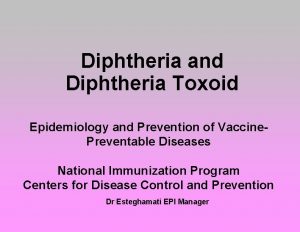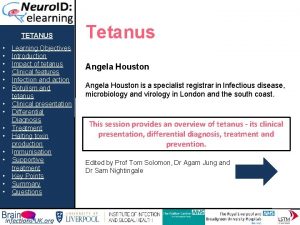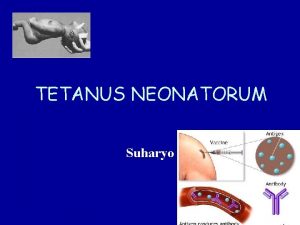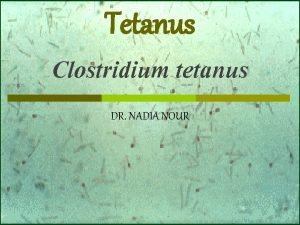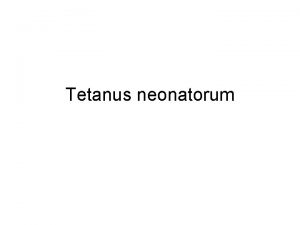Tetanus and Tetanus Toxoid Epidemiology and Prevention of














- Slides: 14

Tetanus and Tetanus Toxoid Epidemiology and Prevention of Vaccine. Preventable Diseases National Immunization Program Centers for Disease Control and Prevention Dr Esteghamati EPI Manager

Tetanus • First described by Hippocrates • Etiology discovered in 1884 by Carle and Rattone • Passive immunity used for treatment and prophylaxis during World War I • Tetanus toxoid first widely used during World War II

Clostridium tetani • Anaerobic gram-positive, sporeforming bacteria • Spores found in soil, dust, animal feces; may persist for months to years • Multiple toxins produced with growth of bacteria • Tetanospasmin estimated human lethal dose = 2. 5 ng/kg

Tetanus Pathogenesis • Anaerobic conditions allow germination of spores and production of toxins. • Toxin binds in central nervous system • Interferes with neurotransmitter release to block inhibitor impulses. • Leads to unopposed muscle contraction and spasm.

Tetanus Clinical Features • Incubation period 8 days (range, 3 -21 days) • Three clinical forms: Local (uncommon), cephalic (rare), generalized (most common) • Generalized tetanus: descending symptoms of trismus (lockjaw), difficulty swallowing, muscle rigidity, spasms • Spasms continue for 3 -4 weeks; complete recovery may take months

Neonatal Tetanus • Generalized tetanus in newborn infant • Infant born without protective passive immunity • High fatality rate without therapy • Estimated 215, 000 deaths worldwide in 1998

Tetanus Complications • • Laryngospasm Fractures Hypertension Nosocomial infections Pulmonary embolism Aspiration Death

Tetanus Wound Management Clean, minor wounds All other wounds Vaccination History Td TIG Unknown or <3 doses Yes No Yes 3+ doses No* No No** No * Yes, if >10 years since last dose ** Yes, if >5 years since last dose

Tetanus Epidemiology • Reservoir Soil and intestine of animals and humans • Transmission Contaminated wounds Tissue injury • Temporal pattern Peak in summer or wet season • Communicability Not contagious

Tetanus – United States, 1980 -2002 Age Distribution

Tetanus - 1998 -2000 Injuries and Conditions Data available for 129 of 130 reported cases. Source: MMWR 2003; 52(SS-3): 1 -12

Tetanus Toxoid • Formalin-inactivated tetanus toxin • Schedule Three or four doses + booster Booster every 10 years • Efficacy Approximately 100% • Duration Approximately 10 years • Should be administered with diphtheria toxoid as DTa. P, DT, or Td

Neonatal tetanus • Suspected case: Any neonatal death between 3 and 28 days of age in which the cause of death is unknown or Any neonate reported as having suffered from neonatal tetanus between 3 and 28 day of age and not to be investigated

Confirmed • Any neonate with normal ability to suck and cry during the first 2 days of life and -who, between 3 and 28 days can not suck normally and become stiff or has spasm
 Primary prevention secondary prevention tertiary prevention
Primary prevention secondary prevention tertiary prevention Difference between descriptive and analytic epidemiology
Difference between descriptive and analytic epidemiology Nutrition epidemiology definition
Nutrition epidemiology definition Difference between descriptive and analytical epidemiology
Difference between descriptive and analytical epidemiology Descriptive vs analytical epidemiology
Descriptive vs analytical epidemiology Certification board of infection control and epidemiology
Certification board of infection control and epidemiology Descriptive epidemiology
Descriptive epidemiology Ukuran asosiasi statistika
Ukuran asosiasi statistika Logistic regression epidemiology
Logistic regression epidemiology Prevalence rate formula
Prevalence rate formula Classification of epidemiological studies
Classification of epidemiological studies Attack rate epidemiology formula
Attack rate epidemiology formula Pros and cons of cross sectional study
Pros and cons of cross sectional study Association vs causality
Association vs causality Attack rate epidemiology formula
Attack rate epidemiology formula
















